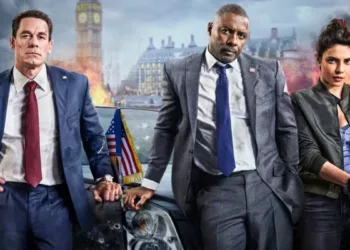There’s a certain comfort, a familiar echo, in the return of a character like Gunnery Sergeant Brandon Beckett. For over a decade, the Sniper series has carved out a respectable niche for itself, becoming a reliable staple for action aficionados who appreciate a story with clean lines and a clear objective.
Beckett, as portrayed by Chad Michael Collins, has evolved into the genre’s dependable anchor, a figure whose presence guarantees a specific brand of straightforward, yet effective, filmmaking. In Sniper: The Last Stand, the eleventh entry, he is once again called from the shadows, this time deploying alongside his trusted, sharp-witted partner, Agent Zero (Ryan Robbins).
Their destination is the politically turbulent, entirely fictional nation of Costa Verde. The setting itself is a loving nod to the action-movie geography of the 80s and 90s, a place like Val Verde where geopolitical complexities are secondary to the mission at hand. They are tasked with supporting the Phoenix Rebellion, a local resistance group fighting to reclaim their country.
Their primary target is the notorious arms dealer Ryker “The Death Broker” Kovalov, brought to life with a delicious, almost theatrical menace by Arnold Vosloo. The stakes are immediately clear: Kovalov isn’t just moving munitions; he is finalizing a powerful new sonic weapon, the “Grim Reaper,” adding a tense, ticking clock to an already volatile standoff.
Deconstructing the Mission Brief
The film dedicates its first half to a careful, almost classical construction of its narrative world. We are introduced to the Phoenix Rebellion squad, a thoughtfully assembled and internationally diverse group of soldiers, and we watch them train, bond, and prepare.
This initial act focuses on establishing Beckett’s reluctant transition into a leadership position, a significant shift for a character who has always been the tip of the spear. His mentorship of Zondi, a young, untested sniper, provides a compelling character arc, forcing Beckett to articulate the grim philosophies of his profession.
The narrative rhythm is intentionally conventional, lulling the audience into the procedural beats of a standard military thriller. Then, with startling efficiency, the film detonates its own premise. The initial raid on Kovalov’s compound goes catastrophically wrong.
In a moment of nihilistic spite, Kovalov activates his own weapon, an act of self-destruction that also wipes out half of the heroic team. This is a bold structural gambit. The film deliberately abandons its carefully laid tracks, upending audience expectation and forcibly pivoting the entire movie into a different subgenre.
It moves from a methodical covert operation to a frantic, desperate siege. This kind of mid-stream narrative disruption feels very contemporary, mirroring the way modern video game campaigns often shift objectives to heighten tension and force players to adapt their strategies.
The Kinetic Language of Survival
What follows the mission’s collapse is a lean, intense, and sustained final act devoted entirely to the raw mechanics of a siege. This is where the film’s artistic and technical merits are most apparent. Director Danishka Esterhazy and her team stage the combat with an impressive clarity, a welcome choice in an era where chaotic shaky-cam can often obscure the action.
The choreography is clean, brutal, and purposeful, allowing the physical storytelling to take center stage. Every sequence is designed to communicate the team’s dwindling options and rising desperation. Specific moments stand out as miniature masterpieces of action design: Hera’s beautifully violent axe fight against a swarm of militia soldiers is a highlight, showcasing fluid movement and visceral impact.
Angel’s one-on-one brawl with a formidable opponent is a grueling, grounded struggle for survival. The sound design is equally crucial, creating an auditory landscape of sharp, distinct cracks from sniper rifles, heavy thuds of physical blows, and the ever-present threat of approaching enemy fire.
It’s a style of filmmaking that respects the geography of a firefight, a trait that reminds me of the great 90s action pictures, where understanding the physical space was key to understanding the stakes. The action here isn’t just spectacle; it is the narrative.
The Faces of the Fight
This installment provides Chad Michael Collins with the opportunity to add new, welcome layers to Brandon Beckett. We see the heavy weight of command settle on his shoulders, watching a man accustomed to taking orders now forced to make the impossible calls that will determine who lives and who dies.
His established, easygoing chemistry with Ryan Robbins’ Agent Zero provides the film with its emotional core, a partnership that feels earned over multiple entries. The casting of Arnold Vosloo as Kovalov was a stroke of genius, tapping into his unique talent for portraying villains who are both charismatic and utterly despicable.
That his magnetic presence is confined to the first half of the film feels like a strategic, if slightly disappointing, choice, prioritizing the siege over a conventional hero-villain showdown. Ultimately, Sniper: The Last Stand is a showcase of exceptional competence within its genre.
It understands its audience and its own identity, delivering a patient build-up that pays off with a ferocious, well-executed action finale. It is a sturdy, well-crafted piece of filmmaking that respects its hero’s journey and stands as a strong example of how to keep a long-running franchise feeling vital and engaging.
Sniper: The Last Stand available on Amazon Prime Video, Apple TV, and Sony’s official store.
Full Credits
Director: Danishka Esterhazy
Writers: Sean Wathen, Michael Frost Beckner, Crash Leyland
Producers and Executive Producers: Darren Cameron, Lance Samuels, Adam Friedlander, Samantha Levine, Tebogo Maila, Sean Wathen
Cast: Chad Michael Collins, Ryan Robbins, Sharon Taylor, Manuel Rodriguez Saenz, Arnold Vosloo, Vusi Kunene, Sizo Mahlangu, Noxolo Dlamini, Rob van Vuuren, Shamilla Miller, Scott George, Hope Thangata, Kathleen Stephens, Kiroshan Naidoo, Duane Behrens, Clayton Evertson, Stavros Cassapis, Sidwell Ralitsoele, Sean Wathen, Dumani Siphosethu Mtya
Director of Photography (Cinematographer): Trevor Calverley
Editors: David Trevail
Composer: Andries Smit
The Review
Sniper: The Last Stand
A solid and well-crafted entry in the long-running series, Sniper: The Last Stand rewards a patient viewer. Its deliberately paced first half builds the necessary foundation for a ferocious and expertly choreographed final act. While the underuse of its charismatic villain is a minor drawback, the film succeeds as a tense siege thriller, anchored by a strong lead performance and clean, impactful action direction. It’s a smart, effective piece of genre filmmaking that knows exactly what it wants to be and delivers on its promise with lethal precision.
PROS
- Intense and sustained final-act siege.
- Clean, well-choreographed, and easy-to-follow action sequences.
- Strong lead performance from Chad Michael Collins, showing character evolution.
- A bold structural shift that effectively raises the stakes.
CONS
- The first half's deliberate pace may be too slow for some viewers.
- The talented main villain, Arnold Vosloo, is underutilized.

















































